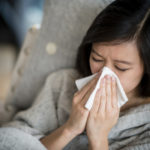Fighting Over The Thermostat? Tips For Cooler Sleep

Your body temperature can have a huge impact on your quality of sleep, so discovering your ideal sleep temperature is crucial. But finding your ideal sleep temperature can be a struggle—especially when everyone in the house has different preferences.
Ideal Sleep Temperature
While sources have found a range of temperatures that work best for deep sleep, the majority agree that an ideal temperature for sleep is somewhere between 60-72° F. Sleeping too hot or too cold can cause you to wake up more often throughout the night and feel more fatigued in the mornings.
When you sleep, your body temperature tends to fluctuate throughout the night, dropping a couple of degrees as you sleep and warming back up when you awake. Additionally, because your body stops regulating its temperatures during REM sleep, it becomes much more sensitive to temperature changes around you.
Beyond your thermostat settings, here are a few more tips for keeping your body temperature regulated throughout the night:
- Sleep in a well-ventilated room to promote airflow by opening windows and/or the bedroom door
- Use a fan, especially in the summertime, to keep the temperature in your room cool
- Don’t ingest sugary or caffeinated foods too close to bedtime as this can increase your body temperature
- Utilize seasonal-specific or thermoregulating bedding
Thermoregulating Bedding
Thermoregulation is the ability to regulate and maintain a consistent core body temperature. Because our bodies fluctuate in temperature throughout the night, temperature-regulating bedding can help by either warming up or cooling you down. When your body temperature is being regulated throughout the night, this can help achieve deep, restful sleep.
Beyond keeping your body at a comfortable temperature for better sleep, one of the greatest benefits to temperature regulating bedding is its ability to be used year-round, keeping you cool in the summer and warm in the winter. Some of the best types of fabrics to help with thermoregulation are natural fabrications such as hemp and linen. Additionally, some types of wool, such as Merino Wool, are good at regulating body temperature as well.
Beyond temperature, humidity and airflow can also have an impact on the quality of sleep. Many natural fabrications that have thermoregulating properties like hemp and linen are also naturally breathable and/or moisture-wicking to help reduce humidity and improve airflow.
Andrew Weil, M.D.
Sources
“Best Temperature for Sleep.” Sleep Foundation. sleepfoundation/bedroom-environment/best-temperature-for-sleep
“Recent Advances in Thermoregulation.” Advances in Physiology Education. journals.physiology/doi/full/10.1152/advan.00126.2014
“Sleep Environments and Sleep Physiology: A Review.” Science Direct. sciencedirect/science/article/abs/pii/S0306456518301335
“Sleeping Soundly: Textiles for a Good Night’s Sleep.” AATCC. aatcc/news2022-12a/
“The Effects of Fabric for Sleepwear and Bedding on Sleep at Ambient Temperatures of 17°C and 22°C.” National Library of Medicine. ncbi.nlm.nih/pmc/articles/PMC4853167/
“What’s the Best Temperature for Sleep?” Cleveland Clinic. health.clevelandclinic/what-is-the-ideal-sleeping-temperature-for-my-bedroom
Today’s Health Topics
Editor's Pick
Health Focus
Ask Dr. Weil's Q&A
| What’s Up, Twitter? |
| Join the lively conversation on Twitter. Connect with Dr. Weil and read up on the very latest in integrative medicine, longevity, meditation, gut health, and more! Follow on Twitter today! You can also find him on Facebook and Instagram. |
|










